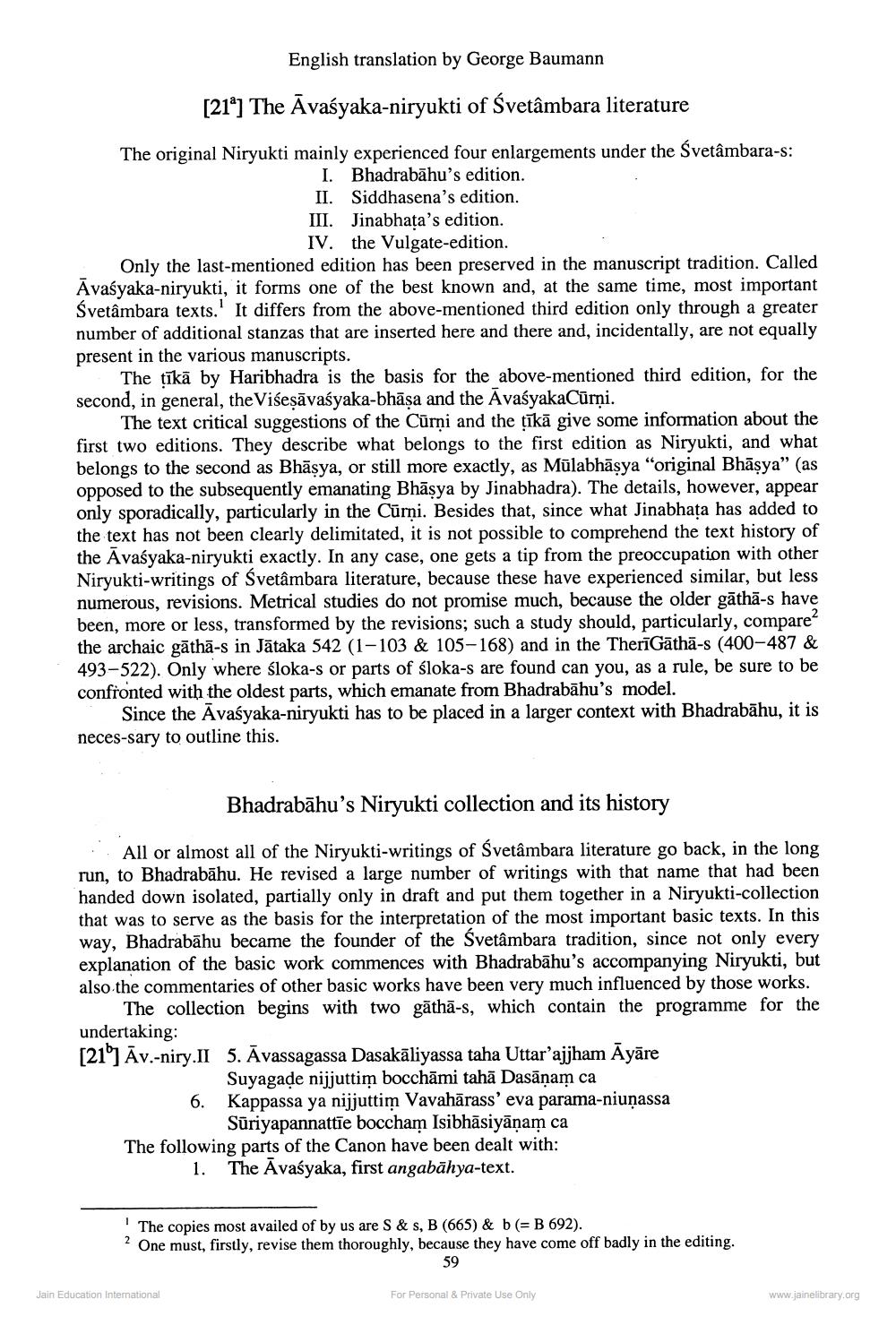________________
English translation by George Baumann
[214] The Āvaśyaka-niryukti of Śvetâmbara literature
The original Niryukti mainly experienced four enlargements under the Svetâmbara-s:
I. Bhadrabāhu's edition. II. Siddhasena's edition. III. Jinabhata's edition.
IV. the Vulgate-edition. Only the last-mentioned edition has been preserved in the manuscript tradition. Called Avaśyaka-niryukti, it forms one of the best known and, at the same time, most important Svetâmbara texts. It differs from the above-mentioned third edition only through a greater number of additional stanzas that are inserted here and there and, incidentally, are not equally present in the various manuscripts.
The tīkā by Haribhadra is the basis for the above-mentioned third edition, for the second, in general, the Viseşāvaśyaka-bhāsa and the AvaśyakaCūrņi.
The text critical suggestions of the Cūrņi and the tīkā give some information about the first two editions. They describe what belongs to the first edition as Niryukti, and what belongs to the second as Bhāsya, or still more exactly, as Mūlabhāsya "original Bhāşya" (as opposed to the subsequently emanating Bhāsya by Jinabhadra). The details, however, appear only sporadically, particularly in the Cūrņi. Besides that, since what Jinabhata has added to the text has not been clearly delimitated, it is not possible to comprehend the text history of the Avaśyaka-niryukti exactly. In any case, one gets a tip from the preoccupation with other Niryukti-writings of Svetâmbara literature, because these have experienced similar, but less numerous, revisions. Metrical studies do not promise much, because the older gāthā-s have been, more or less, transformed by the revisions; such a study should, particularly, compare the archaic gāthā-s in Jātaka 542 (1-103 & 105-168) and in the TherīGāthā-s (400-487 & 493-522). Only where sloka-s or parts of śloka-s are found can you, as a rule, be sure to be confronted with the oldest parts, which emanate from Bhadrabāhu's model.
Since the Āvaśyaka-niryukti has to be placed in a larger context with Bhadrabāhu, it is necessary to outline this.
Bhadrabāhu's Niryukti collection and its history
All or almost all of the Niryukti-writings of Svetâmbara literature go back, in the long run, to Bhadrabāhu. He revised a large number of writings with that name that had been handed down isolated, partially only in draft and put them together in a Niryukti-collection that was to serve as the basis for the interpretation of the most important basic texts. In this way, Bhadrabāhu became the founder of the Svetâmbara tradition, since not only every explanation of the basic work commences with Bhadrabāhu's accompanying Niryukti, but also the commentaries of other basic works have been very much influenced by those works.
The collection begins with two gāthā-s, which contain the programme for the undertaking: [21°) Āv.-niry.II 5. Āvassagassa Dasakāliyassa taha Uttar'ajjham Āyāre
Suyagade nijjuttim bocchāmi tahā Dasāṇam ca 6. Kappassa ya nijjuttim Vavahārass' eva parama-niunassa
Sūriyapannattīe boccham Isibhāsiyāṇam ca The following parts of the Canon have been dealt with:
1. The Avaśyaka, first angabāhya-text.
The copies most availed of by us are S&s, B (665) & b (= B 692). ? One must, firstly, revise them thoroughly, because they have come off badly in the editing.
59
Jain Education International
For Personal & Private Use Only
www.jainelibrary.org




